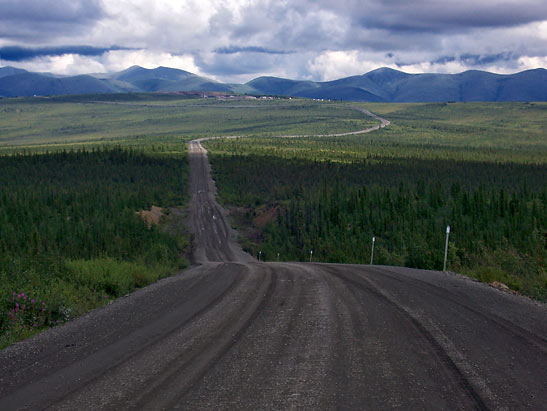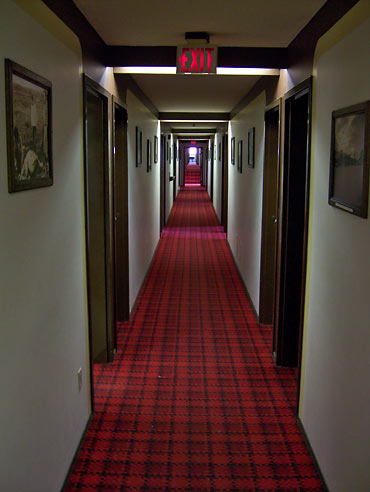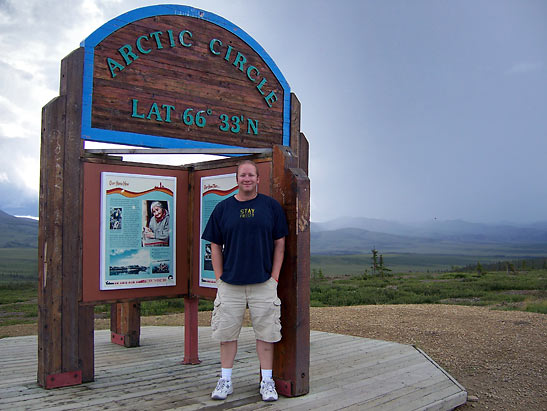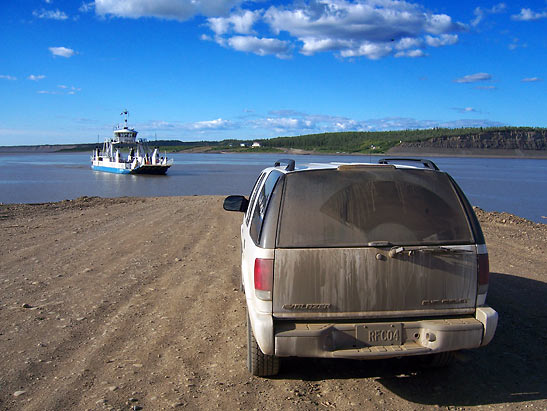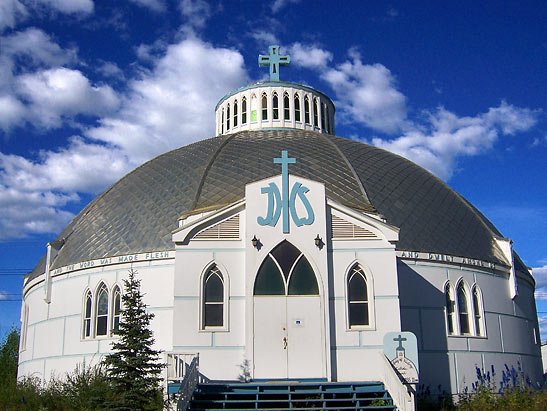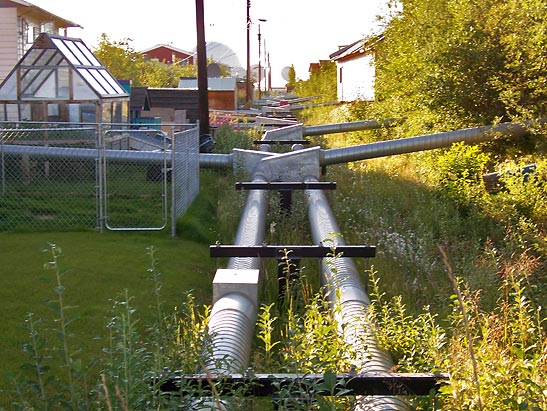 |
 |
|
 |

|
37 Above 60, Part
II
Story and photographs by Adam Sholder The Dempster
With my video camera atop its tripod, which I had secured firmly to the passenger seat with bungee cord, I shifted into drive. Soon I found myself driving on gravel and entering a forest of Black Spruce. My Sirius satellite radio was picking up some great classic rock, and I pushed on for about an hour or so, until I reached Tombstone Recreation Area, where the road begins to ascend into the Ogilvie Mountain Range. I stopped at the Interpretive Center and talked with the Ranger for a while. He, like almost everyone I had met so far, wanted to know about the camera I was carrying – a Panasonic DVX, not a small point-and-shoot kind that most travelers would carry. Mine was much larger, with a large lens and shotgun microphone attached to its side. I had been asked if I was with the news, or if I was filming for the CBC, or sometimes it was just, "Hey, that's a nice fuckin' camera, ay?" A quick note – almost all Canadians I’ve met swear. Young and old, men and woman – their acerbic tongues did not discriminate. But Canadians are such a warm, friendly, unassuming bunch, with such a pleasant, lilting accent that the words just roll out in a very casual, inoffensive way. I loved it. The young kid working at the Tombstone Interpretive Center was no different: “Gee, that’s a nice fuckin’ camera. What’cha doin’ with it?” “I’m just making a little film of my trip up the Dempster.” “Shit, how far ya’ goin’, ay?” “All the way to the Arctic Ocean” “Oh shit, that’s fuckin’ wicked, ay?” “Yes, it is fucking wicked. Fucking wicked indeed.” “Well ya heard aboot the five people got killed on the highway up by the border there, ay?” Yes, I had heard. Nearly everyone I’ve met has told me about it. Comforting. We chatted for a while about marmots, and then I shot some video by the creek. Then I was back on the road. The highway is made entirely of gravel, built straight up as high as 20 feet in some places. It curves and dips, it is uneven and filled with potholes, there is often no shoulder, and there are no guardrails of any kind, even when ascending though mountainous passages snaking over precipitous cliffs. The road is covered with shale in many places, a sharp, jagged stone that can easily shred a tire in an instant. And, there are no services until the halfway point at Eagle Plains, at mile 220.
I began the ascent into the Ogilvie Mountains, the first range I would pass through on the journey. I drove through some stunning vistas, and stopped to get some footage. As I turned a bend in the road, I got my first breathtaking eyeful of the sweeping Sub-Arctic tundra. As far as I could see in any direction – easily hundreds of miles – the landscape of rolling hills was covered in a hirsute of small, green, mossy bushes. Bright blue bodies of water – hundreds of them, in all shapes and sizes, were the only things that interrupted the greenery. Not a tree in sight. And, other than the gravel on which I rode, there was no hint of human presence, past or present. Spectacular. I pushed on through, vista after endless vista, all washed in a palate of greens and blues – the land, the lakes, the sky. Unless you count the white clouds, which I noticed were getting a bit darker. The road rolled on, through stunning mountain passes, through impossibly narrow canyons, and through endless, lake-filled valleys. The skies, which were at first a deep blue filled with perfect white clouds, were now darkening to an ominous gray. Within minutes it began to rain. I traveled on through the bottom of a narrow valley, where a few trees were hiding. My car, already quite dusty from the streets of Dawson, was now covered in a thick layer of dirt. I couldn’t see out the back window at all, for all of the grime. It rained heavily for a few minutes, but overall it was a fairly short storm. Soon the sun reappeared and seemed to cast a whole new light on the scenery. In fact, the landscape seemed to transform itself with every curve of the road. With varying light and elevation it was a constantly changing vista. I continued on through the valley floor when my satellite radio finally quit on me. There was no more signal to be found. I switched to my mp3 player. I drove past Engineer Creek Campground without stopping at the Interpretive Center. I didn’t need to hear, yet again, about the tourists who ran off the road. As I turned a bend in the road in a particularly heavily wooded area I came car-to-face with my first “Yukon Blonde” – a grizzly bear. Not 50 feet in front of me stood the enormous creature. I came to a stop and he turned to look at me. His eyes met mine straight through my chipped-up windshield, and we regarded each other for a brief, tense moment. It was just the two of us, and he must have been three times my size. After careful deliberation on his part (I assume choosing whether or not to eat me), he padded down the side of the road and was lost to the thicket of trees. It was getting late, about 10:30, but still light despite the cloud cover. I finally ascended out the valley and into another pass when I hit a fog bank that reduced my visibility to less than 10 feet. I was crawling along down the center of the road, where I was doing most of my driving anyway, as you pass almost no one, and when you do, you usually see them coming from miles away. I was hoping that should I meet anyone coming from the other direction, they’d be going just as slow as I was in this thick, white haze. Then, in an instant, with not so much as an, “I’ll fuckin’ catch’ya later, ay?” the fog was gone. But, the “low fuel” light had turned on. I was sure that my initial estimates were right, and I had plenty of fuel to get to Eagle Plains. I was doing a quick re-figuring of my kilometers-to-miles calculations, when the next fog bank hit just as hard as the first. I thought I saw a sign for Eagle Plains, but how far? I was at the top of a summit with no end in sight. Then the fog broke. And then it was back. It carried on like that until almost midnight, as did the car, seemingly riding on fumes, when in the middle of the darkest fog bank I rolled up on the Eagle Plains Lodge. The inaptly named lodge (located on an eagle-less summit) offered food, gas, tire repair, a few motel rooms, a campground, and limited airstrip facilities. I had initially intended on camping. However, it was very cold and windy, the fog remained thick as my grandmother’s homemade pea soup, and I was quite exhausted. If there was a room available, it had my name on it. I entered the lodge, passing a stuffed caribou on my way to the office. Blood-red carpets trailed off down long, narrow hallways. The walls were covered with “death” pictures of the three frozen men from the Lost Party of 1911. I saw not another living human in the place. I suddenly had the eerie feeling I had just walked into a forgotten “ghost-lodge” that rises out of the fog, beckoning travelers to their doom. The office was closed, but the sign said, “See bartender for rooms.” The Eagle Plains Lodge I found my way into the lounge, across the lobby of the lodge. A dozen people, all clearly locals, were drinking and talking, and everyone in the joint came to a sudden and abrupt stop when I walked in. All eyes shifted to me, the big pale guy with the camera walking into the lounge at the stroke of midnight in the middle of the middle of nowhere. I nodded a few greetings and then turned to the bartender, a girl barely old enough to drink herself. Before I could ask for a room, she announced last call, and everyone in the joint ordered three more beers apiece. I ordered a shot of Canadian Club with a Molson’s Canadian back, to celebrate my arrival. I exchanged my signature on a credit card receipt for a room key, and was working on my Molson when I noticed a large man wave me over to his table. I walked over and he pushed a chair out for me with his leg, motioning for me to join him and his two buddies. They seemed to be a few Molson’s to the wind themselves. Turns out they were three Gwich’in men from the tiny town of Fort McPherson who had been fishing all day. “The fishin’s been fuckin’ great, ay? Caught us some trout and grayling almost twelve inches long. Been drivin’ all up and down the road stoppin’ at every creek and river. You fish, ay?” “Well, I’m not much of a fisherman…” I admitted. “Shit, cousin, you gotta get down to Klondike Corner and drop a line!”
So there I was sitting with Kenny, Perry, and Keith, talking about fishing and the grizzly I saw and the fog. A deep-blue twilight streaming in through the mist filled the windows of the lodge. Twenty minutes later, with my beer quite finished, I shook the meaty hands of my new cousins and called it a night. I awoke early the next morning and looked out the window. The fog was thicker than the night before. There would be no way to drive in this. I spent a little time in the room, and then went for breakfast in the dining room. By the time I was done eating, the fog had lifted and I was ready to go. However, there was a buzz of activity in front of the lodge, and there would be another hour of conversations with friendly strangers. A motorcyclist asked me about the road conditions to the south. A middle-aged couple asked if I had seen any grizzlies. A young family man advised me on some driving tips along the road. It seems as if everyone had something to say about something. And, of course, everyone reminded me of the five who died last week, just up the road a bit from here, near the border crossing into the Northwest Territory. I was warned that the road gets really bad just north of the lodge, made worse by the rain and fog, and I should be, “Extra fuckin’ careful, ay?” The Signpost at the Top of the World It was now 11:00 and they skies were iffy, at best. I filled up the tank and headed out. The next dozen miles or so weren’t too bad, with some foggy patches here and there. And then I reached another milestone of the trip – the Arctic Circle. I pulled off the road to step out and take a few pictures and video of the signpost. I stood there alone in utter silence, admiring the very best that nature has to offer. I must have stood there for thirty minutes, uninterrupted, in silent reverence. An ominous boom of thunder broke the glorious silence. I instantly recalled walking into Chatres Cathedral in the French countryside, outside of Paris, many years ago. As I entered the doorway of this magnificent thousand-year-old cathedral, a thunderclap roared in an otherwise sunny sky. It was a powerful and profound moment of my life. And here I was, standing at the Arctic Circle, a doorway to one of nature’s own ancient cathedrals, and a loud thunderclap again punctuated another overwhelming and poetic moment.
Disturbingly dark clouds had now moved in behind me and quickly covered the sky. The thunder became louder and more frequent and louder yet, and seemed to echo against the mountains that rose from the tundra miles away. Rain began to drop, lightly at first, then steadily harder and harder. It was time to move on. Back on the road things quickly got a bit dodgy. I had hit that much-talked-about “rough” spot on the road. It was rutted and pockmarked and narrow. The rain and thunder picked up in intensity, and so did I. My hands gripped the wheel and I struggled to see, even with wipers sloshing at full tilt. The numerous potholes quickly filled with water and blended in with the gravel, making them difficult to distinguish until I was on top of them. The car bucked and bounced, splashing up great sprays of water. Bolts of lightning flashed in front of me, lighting up the ethereal landscape. I was in my element. I love the rain and to be caught in a storm of this magnitude in this part of the world was more than I could have asked for. Then it really started to rain. Blankets of water seemed to move sideways, buffeting my car. The road literally turned to a river of slick mud, and now driving was truly impossible. I pulled as far over onto the soft shoulder as practical, and sat in total amazement at the force of the rain. The wipers were useless, and my car was awash in thick mud. I rolled the video camera, sat back and enjoyed nature’s powerful display. Ten minutes passed and the rain had diminished enough that I felt it was okay to drive, and I had a lot of wet ground to cover. The road was still slick, and the potholes remained a constant obstacle, but my four-wheel drive was up to the task. While the weather slowly improved, the road itself worsened. The gravel was looser and made worse by the rain, and although I found myself sliding around a bit, I continued on. The skies were finally starting to clear in front of me, and a quick look behind me confirmed the storm was rolling away, a goliath roaming the tundra. By the time I reached the border crossing, the skies were again bright and blue. At the summit that serves as the dividing line between the Yukon and the Northwest Territory, I came across three travelers from France. They were making the same journey, from Whitehorse to Inuvik. However, they were doing it by bicycle. It made my three-day, camping-by-bike trips to Catalina Island almost seem embarrassing. They had been en route for five weeks and seemed in bright spirits. We talked for a long while in the cold, gusty wind atop this summit before taking some pictures and exchanging Merci Beaucoups and Bon Voyages and Au Reviors. For days it had seemed as if I had been climbing the side of the very Earth herself, pulling my self ever upward over uncertain terrain. Now, as I descended the final summit on the last bit of unstable road, it felt as though I had made it over the final precipice, heaving myself up to a safe and secure plateau. Not long after entering the Northwest Territory I rolled onto the ferry for the short trip across the Peel River. In the winter, the river freezes and you can simply drive across it on an ice bridge. But, in the summer, a two-car ferry stands at the ready for the random traveler or supply truck. On the other side of the Peel I made a quick stop in Fort McPherson for gas and water, then Northward once again. The road, while still gravel, was wider and flatter and smoother, and I could reach speeds of 90 kilometers per hour (55 mph). Soon I boarded another ferry, again as the only passenger, and crossed the McKenzie River, second in length and volume in North America, to be outdone only by the mighty Mississippi. It drains a full one-fifth of all of Canada. Now, it would be only an hour or so on the road until I reached Inuvik.
Inuvik I was zipping along the tundra heading straight for the Beaufort Delta. The McKenzie river begins far to the Southeast at The Great Slave Lake near Yellowknife, the capital of the Northwest Territory. It heads north from there, eventually draining into the Arctic Ocean at the Beaufort Sea, creating one of the world’s largest, natural deltas. As a result, the tree line extends further north here than anywhere else on the planet at this latitude. The Spruce, however, are short, spindly, and sparse, and only grow near the water. And, there are no mountains. The land stretches on and on with nothing to interrupt the view for hundreds of miles in all directions. Soon, I passed by the sign to Jak Park, where I would be camping. It was about 10:00pm and the sun was higher in the sky than I had ever seen at this hour. I bypassed the park, opting instead to head straight into Inuvik to pick up some supplies. A few minutes later I was in what passed for their downtown. Inuvik had none of the charm of Dawson, but a unique atmosphere all it’s own. The town was built by the government in the 1950’s to replace the native village of Aklavik, some 60 miles to the west, which was sinking into the permafrost. However, the locals tell a different story of how this was just an excuse used to create a hub for the emerging oil business in the region. To this day, Inuvik serves at the center of commerce for the Canadian Western Arctic, including oil, transportation, communication, and the environment. However, it is still populated mostly by the Inuit and Gwich'in. All of the buildings sit atop log or steel pilings, 4-5 feet off the ground, so the heat transfer doesn't melt the permafrost beneath. Long metal tubes known as Utilidors run above ground between all buildings. The permafrost also prevents pipes from being buried underground, so these Utilidors house the lines for water and waste. Most buildings look like government-built structures of the 50's, save the Catholic Church in the center of town built to resemble an igloo.
The town, even at this hour, was abuzz with activity – mostly teens and younger children on bikes or skateboards speeding through the streets. And there were taxi’s running to and fro – a non-stop stream of them it seemed – a peculiar sight in such a small town. I stopped in Max’s News Stand, the local convenience store, for a few items and noticed the headline on the local paper – "Grizzly Scare in Delta." The second heading on the page read "Five Die in Dempster Crash." I pulled into beautiful Jak Park campground, situated on a bluff overlooking part of the delta, and it quickly became obvious that I was the only one there. The grounds were empty. I checked in with the attendant, who warned about the bears. It seemed that Inuvik was a bit overrun with them this summer. Seven of them had been hanging around the park, and a few had been heading into town. One even pushed its way into a house by the lake around two in the morning the previous week, giving the owner’s out-of-town visitors quite a start. Determined bears, swarms of steroid-using mosquitoes, and the bright midnight sun conspired together, prompting me to seek safety in the shelter of my SUV – I opted to sleep in the back instead of my tent. Related Articles: |

FEEDBACK FOR PATTI I enjoy your newsletters -and particularly Patti Nickell's article
about the 'Pudding Club' in the Cotswold's. An old friend of mine is taking
a holiday there this year and plans to try their Jam Roly Poly and Spotted Dick
- amongst many!
FEEDBACK FOR JULIO The way I read this article, you stayed at the "Breeze
and Waves". Do you have any pictures of the cottages, and would you recommend
to some first time visitors to Caramoan? Hi Richard, Breeze and Waves was still under construction when I stayed
there in Feb. 2010. It should be finished by now. You
can see pictures of the resort on this page. We got to stay in one of the
small cottages in the picture. I'll recommend it to budget travelers but you
might want to look at other options. We chose it because of its location right
by the beach. You can try other resorts in the Caramoan town proper (you have
to get a ride to get to the beach and the jump-off point to go island-hopping
but it's a relatively short distance). There are also two higher end resorts
located on a cove and very near the islands: Gota Village Resort (unfortunately
there is something wrong with their website right now) and its twin resort Hunongan
Cove. Caramoan is a relatively new tourism development so resorts are just now
being built. I should add that it might be good to go to Caramoan (and almost anywhere in the Philippines) during the dry season from December to May. June to November are the typhoon months and sometimes typhoons will still come during early December. Julio * * * * * Hi, I'm planning to go to Caramoan this coming May. Would you
know the number of Breeze and Waves Cottages? Thanks! Hi Ann, Breeze and Waves' phone number is 0908-2911072. Look for Freddie. Hope you have a grand time at Caramoan! Julio
FEEDBACK FOR WENDY For Nature's Playground: The South Island of New Zealand Hi Wendy, In winter, Heritage Heights Apts. now offers free shuttle service to and from Queenstown 24/7 to guests without cars. We own a 7-passenger 4-wd Toyota Highlander used specifically to taxi guests up and down the hill during winter months. We also run advance purchase winter promotions which include a 4-wd rental. If any of your readers head over this direction, I will enjoy extending Heritage Heights hospitality!! Cheers --- Ailey, Owner, Queenstown, NZ * * * * * New Zealand text and pix top drawer! Almost as good as making the trip. ( but one still wants to. . . ) Full of useful detail. Only trouble with the website: It's tough figuring out which feedback goes with which article, and the more there are, the tougher it gets! --- Ken W., Camarillo CA Thanks Ken..."álmost" is right, you really have to experience the South Island firsthand. Granted this piece is long, but still all I can think about is how much I left out! I agree abut the relevancy factor re the feedback--it can be confusing...sometimes I have a "Wait a minute...what?" moment myself. Thanks for writing, Wendy * * * * * Okay Wendy, from now on whenever you book your travel, please reserve space for me. I will carry your luggage, bring you cold drinks, massage your shoulders, and change the film in your camera (oops, I guess you don't have to do that anymore). Wonderful ideas and recommendations. Can you get to New Zealand from Boston in less than a week? --- Carl A., South Easton, MA Ha ha ha Carl, you're quite the comedian! But you'd be surprised how short that flight feels. I suspect Qantas isn't the only airline who's figured out that 3 movies, 2 full meals, lots of snacks and a complimentary travel pack (eye mask, warm socks and neck pillow) equals a quiet, well-behaved cabin. It really isn't bad. Just fly direct--pick the shortest flight w/ no lengthy layovers and you'll be fine. Re: signing on as my Super Sherpa...why not? I think you know I seldom travel in anything less than Party mode. There's just that pesky background check... Thanks for writing, Wendy For Excellence Riviera Cancun: Wendy, I truly enjoyed your info especially since we leave in a week to celebrate my 50th Birthday. Was it necessary to make reservations at the restaurants? Was there a dress code for the restaurants? What would you recommend not missing while there? Was the spa experience worth it? Did you travel away from the resort while there? Thanks, --- Kim P. Fuquay, Varina, NC Hi Kim. Sorry for the delay in responding...you had heavy competition with the holidays. Reservations at Excellence restaurants are not necessary and you will not find a wait. The dress code is basically no bathing suits and flip-flops...with a decided a mix of atmospheres. Mostly the open-air beachside spots are super casual, the rest slightly more formal. Truly, as long as you are clothed, I don't think you'd be turned away anywhere, though most people seemed to enjoy dressing up at night...I suspect more for their own pleasure than any sense of decorum. The spa experience was worth it, though my favorite part wasn't the actual massage. The precursor was a 45 min. or so rotation from sauna to a series of (kind of wild) water jets which was very different and very cool, not just for women. In its' entirety, and with the serenity of the beach/champagne/strawberries, it was memorable. We did not travel away from the hotel this trip, but the hotel is very helpful in arranging day excursions to fit your desires and you do not have to book these until you arrive. Have a great time! --- Wendy
FEEDBACK FOR NINO I enjoyed Nino's contribution, since we all read about the frightening
terrorist attack. Having travelled somewhat through India years ago, I am continually
impressed with this country and the gentle spiritual aspects of this nation.
Some day I look forward to going back. Nino has encouraged me. Thank you!
FEEDBACK FOR RUSH & CHUCK Dear Mr.s/counselors Brown and Koro, Thank you for a very informed and succinct article on motorcycle accidents and the law. It inspired me to think about getting a motorcycle, but not have an accident. But, if I do I am now well informed with the basics of what to do providing I do not perish in the accident. Any tips about that too? --- Unnamed
Dear Rush and Chuck, I wish I had read your article before our camping trip the Friday prior to President's Day. My wife and I were in a car accident on our way to a camp ground. We were "rear-ended" and the impact caused our car to crash into the car in front of us. The contents of the truck that we were riding scattered onto several lanes. It's a miracle our two dogs decided to stay inside the car. My wife and I were shaken up badly but despite the mess, I was still able to walk out of the car. I got the license plate of the driver in front of me but, to my surprise, after reviewing the little damage on his car, he then sped off. I didn't know you could do that! The driver who hit me from behind gave me his information and then he too left the scene without saying good 'bye. When the police arrived all I had to go by was the little information I had jotted down which I hope was truthful. What if it was bogus? What if I had written the plate number incorrectly? How would that affect my insurance? What if we were unconscious, who would have written down all that information? I do have one suggestion if you are injured in an accident. The police asked if my wife wanted an ambulance to bring her to the hospital but we declined the offer. I remembered when I rode an ambulance years ago that it was not a comfortable ride. I was strapped to the stretcher and there were all sorts of medical equipment dangling noisily above me. As long as you are able, it is a more relaxful ride inside a car. Besides, isn't there a fee for ambulance service? --- Dave S. of Pasadena, CA
|
This site is designed and maintained by WYNK Marketing. Send all technical issues to: support@wynkmarketing.com

|











